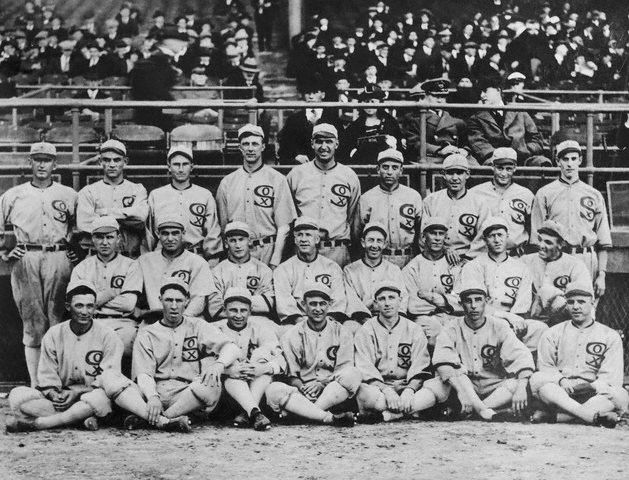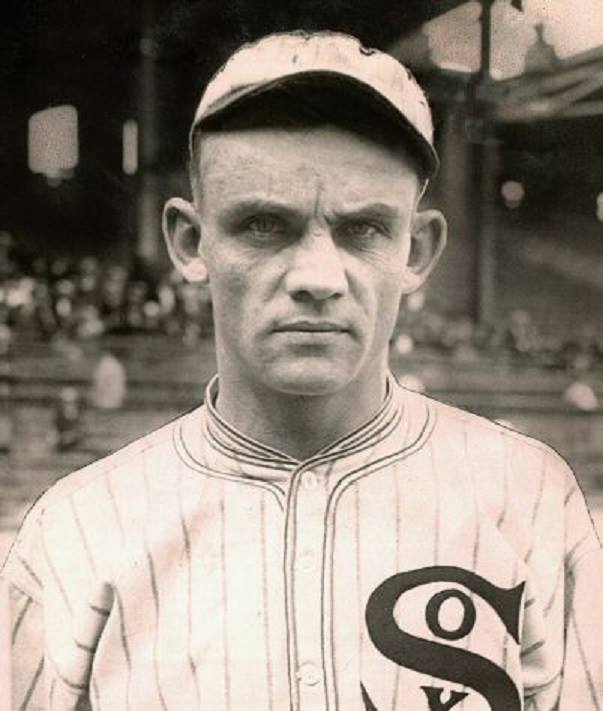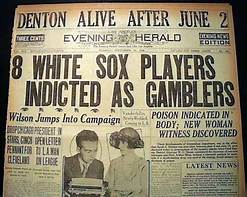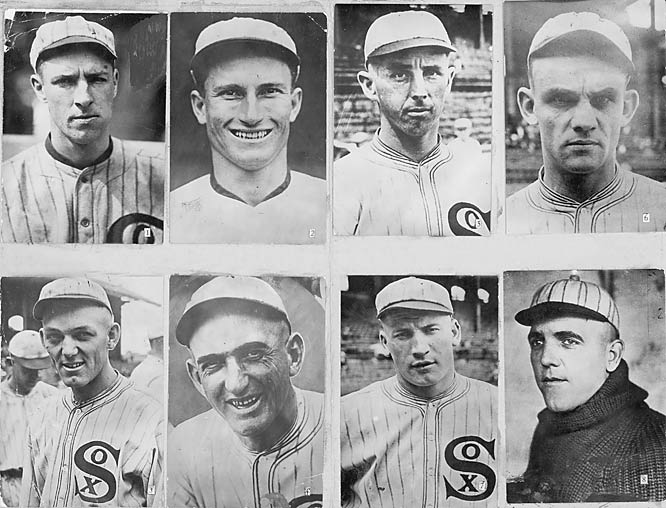Featured Panoramic Photo Above:
Classic Charles Conlon photo of Ty Cobb sliding into Jimmy Austin
Baseball History Comes Alive Now Ranked As a Top Five Website by Feedspot Among All Baseball History Websites and Blogs!
(Check out Feedspot's list of the Top 35 Baseball History websites and blogs)

Guest Submissions from Our Readers Always Welcome! Click for details
THE BASEBALL HISTORY COMES ALIVE BLOG
Here’s a link to see the entire Blog Archives
October 18, 2022
Today I’ll conclude my weekly “deep dive” into the Black Sox scandal as I try to sum up all my thoughts about the scandal that rocked the baseball world to its core in 1919.
(Featured photo above of the “Eight Men Out”, top row, L-R: Swede Risberg, Fred McMullin, Lefty Williams, Chick Gandil. Bottom Row, L-R: Buck Weaver, Joe Jackson, Hap Felsch, Eddie Cicotte)
A special thanks to all of you who have been following along with this series of essays on the Black Sox scandal. I hope you’ve enjoyed them and found them of value. I also hope the essays have opened your eyes a bit and you’ll now agree with me that we haven’t been told the entire story. If that’s the case, then I’ve succeeded in my intention when I started writing about the scandal back in 2019.
This essay, along with all the others I’ve posted in this series, is a slightly edited version of the one that originally appeared in my 2019 book, Reflections on the 1919 Black Sox: Time To Take Another Look, available on Amazon. Again, it’s a bit long, but if you’ve been following along with this series of essays, I think you’ll find it interesting. -GL

New Blog Topic:
Concluding Thoughts to My Black Sox Essays
Throughout this collection of essays, I have attempted to make the point that the conventional wisdom regarding the Black Sox scandal and the 1919 World Series does not tell the complete story. Certainly, there is more to say about it than simply eight members of the heavily-favored White Sox, angry at skin-flint owner Charles Comiskey, banned together and conspired with gamblers to “throw” the World Series for a big payoff.
Then, as the story goes, their plot succeeded. The “fix” was in, they lost the Series, the gamblers cleaned up, and the eight Black Sox got their money, although not as much as promised. A year later, under increasing scrutiny, some decided to come clean, confessed, were acquitted in court, but were banned for life by Judge Landis.
Even if you accept this superficial version, I hope you can at least agree with me that there were, at a minimum, differing levels of guilt and involvement. A one-size-fits-all punishment, which was the verdict doled out to the eight players by Judge Landis, does not now seem warranted from our vantage point one hundred years later.
I ask you to read again these quotes from Chick Gandil, from his 1956 interview for Sports Illustrated, commenting about the team’s state of mental disarray as the start of the World Series approached:

“I truthfully wanted to go to our manager Kid Gleason and tell him the whole story, but I knew it wouldn’t be that simple. I realized that things were too involved by now to try to explain. I guess some of the others must have felt the same way, because the next morning I was called to a meeting of the eight players. Everyone was upset and there was a lot of disagreement.”
“But it was finally decided that there was too much suspicion now to throw the games without getting caught. We weighed the risk of public disgrace and going to jail against taking our chances with the gamblers by crossing them up and keeping the ten grand…Our only course was to try to win, and we were certain that we could.” [Emphasis added] [1]
Granted, Gandil was a shady, unreliable character and a known liar; but I don’t think his words can just be dismissed out of hand. As I’ve tried to point out with the general theme running throughout the essays, an honest assessment of much of the circumstantial evidence seems to support his claims.

I’ll reiterate and elaborate upon the conclusions I’ve reached over the course of my study of the 1919 World Series and the Black Sox scandal. I’ve stated different versions of these conclusions numerous times throughout the essays:
My Conclusion
So what really happened? No one will ever know for sure. But after reading the first-hand accounts of those involved and those who were actually there, it’s my contention that In the days before the start of the the1919 World Series, the entire sordid episode became a blurred, surreal sequence of events where no one really knew what anyone else was doing or thinking. A few may have cracked under the intense mental stress, as Chick Gandil implied in his interview. Conflicting stories and emotions were rampant. Here’s some thoughts that had to be running through their minds:
“Is it really worth the risks? Who’s still in? Who’s out? Are you even sure we’re getting the dough? Is it too late to call it off? We took the money. Now what? Is it too late to give it back? We made a ‘devil’s bargain’ with gamblers. What happens when you double-cross gamblers? Can we even get away with it? There’ll be thousands of people watching our every move, how do you throw a game, anyway? Which games do we throw? I’m scared! What if we get caught?”
All this and much, much more had to be mentally tormenting them as the crucial hour approached. Who could possibly concentrate on winning baseball with this mental baggage? On a national stage, no less, and against a strong team like the Reds.
The situation Was Ripe For Upset…
As I’ve said many times, it’s never been my intention to exonerate the Black Sox; but merely a suggestion that we need to uncover the truth buried deep beneath the mountain of lies, distortions, and conflicting emotions. Conspiring with gamblers is less of an offense than actually throwing games. Proper levels of guilt need to be assessed. The prevailing version whitewashed the baseball establishment, which had turned a blind eye to the gambling scandal eating away at the game. Many of the Chicago and national sportswriters were Comiskey cronies—members of the famous Woodland Bards. They had a vested interest in minimizing the damage to Commy’s reputation and to the baseball establishment.
I contend it’s entirely plausible that as the start of the Series approached, the thought of playing “crooked ball” was too much for at least some of them to handle. They were “big shots” who like to talk big. Commy was an easy target.
“Here’s a chance to get back at that cheap bastard, a chance to really make some real dough…”
But when push came to shove, as the time approached to take the field, could they have lost their nerve? Could remorse—or even panic—have set in? It wouldn’t be the first time conspirators backed out as the reality of illicit decisions set in.
With rumors of a fix flying around, it was easy to accuse the heavily-favored White Sox of crooked play, even if it was just poor play by preoccupied players saddled with extreme mental baggage.
The 1919 Black Sox were an extraordinary mix of arrogance, stupidity, naivety, greed, and, yes, talent. Conspiring with gamblers to throw the World Series was a serious offense. They got what they deserved and they knew it. The acceptance of dirty money irreversibly tarnished their reputations and made their future protestations of innocence ring hollow:
“We took their money but we double-crossed them by trying to win.”
Yeah, right…You expect us to believe that? No, once they touched the gamblers, and dirty money was given and accepted, their fate was sealed. As with a tar baby, they could never break totally free.
Are you starting to feel, as I do, that perhaps there’s more to this sordid story than meets the eye? If so, then I’ve succeeded in my objective with this series of essays. Again, I don’t know what really happened, but I think there’s a lot more to this story than we’ve been led to believe. I only offer up this book as “food for thought.”
I do think it’s time for another look at the 1919 Black Sox with pursuit of the truth as the only goal. Let the chips fall where they may.
Gary Livacari
October 2019
[1] Sports illustrated, September 17, 1956
As always, we enjoy reading your comments
Here’s a link to see the entire Blog Archives



You have hit the nail, Gary, as well as anyone possibly could. Well done!
If anyone disagrees with your analysis, I hope they’ll take this opportunity to explain their thinking.
Michael
Thanks as lot Michael…I’m a contrarian by nature, so a renewed look at the events surrounding the scandal came naturally to me, especially when I read the accounts of the baseball lifers who were actually there (including the umpires, the official scorer, most of the press, the Reds players, and even the vast majority of the fans). Let’s hope others are as open-minded on this emotionally laden topic as you and I. As my title suggests, now, over a hundred years later, it’s time to take another, unbiased look.